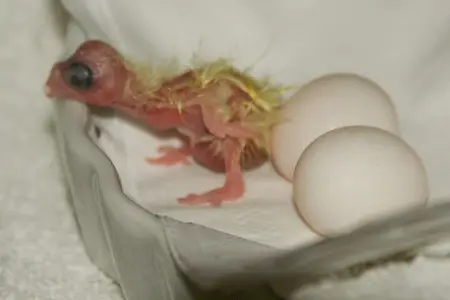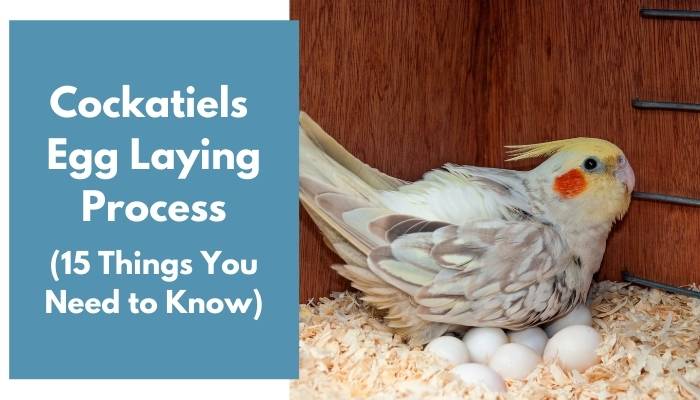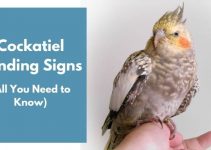Like all other birds, cockatiels also have their egg-laying process, and it takes about 2-3 days. Female cockatiels produce eggs starting in the ovary. It may or may not get fertile, depending on whether it mates or not. The fertile ones have the potential to hatch, while the infertile ones don’t. Cockatiels usually lay one egg at a time with an interval of 2 days or 48 hours. It won’t stop laying until the whole clutch is out, generally consisting of 2-8 eggs.
We must understand this process and everything that it includes. This way, we can support our pets and give them anything they need to stay healthy and safe during these moments.
Here are 15 usual questions and topics you should know about the cockatiel’s egg-laying process. Learning these things may help you care for your pet.
Moreover, it may come in handy if you own a female cockatiel and even other female birds.
Without further ado, let’s get into it!
Contents
- 1 How often do cockatiels lay eggs?
- 2 When do cockatiels lay eggs?
- 3 How many times does a cockatiel lay eggs in a year?
- 4 At what age do cockatiels lay eggs?
- 5 How long does it take for cockatiel eggs to hatch?
- 6 Do cockatiels lay unfertilized eggs?
- 7 Can you touch cockatiel eggs?
- 8 Why do cockatiels not sit on their eggs?
- 9 How can you tell if a cockatiel egg is going to hatch?
- 10 Should I remove my cockatiels eggs?
- 11 How do I stop my female cockatiel from laying eggs?
- 12 Cockatiel laying eggs without a mate
- 13 How many times do cockatiels mate before they lay eggs?
- 14 At what age do cockatiels stop laying eggs?
- 15 Cockatiel not sitting on eggs – what to do?
- 16 How long can a cockatiel egg go without being sat on?
- 17 Summary
- 18 Resources
How often do cockatiels lay eggs?
Cockatiels lay eggs as often as every other day per clutch. A clutch is the group of eggs produced at a single time, particularly those laid in a nest. These birds often have four to six eggs in each egg clutch. Thus, they may lay eggs six eggs every other day within 12 days.
If it’s your first time seeing your cockatiel lay eggs, it’s essential to expect up to eight eggs.
During the laying period, it would be best to support your pet by providing food and fresh water all the time.
Moreover, it would be best not to intervene until you see that your pet stops laying eggs after a few days.
Lastly, they usually incubate the eggs for 20 days after laying. If your cockatiel isn’t doing so within a few days, it would be best to remove it from the nest.
You May Also Read – Do female cockatiels sing and talk?
When do cockatiels lay eggs?
Cockatiels lay eggs within three weeks of mating. They lay their eggs one at a time, and it can happen every 48 hours. A clutch of eggs usually consists of 4-6 eggs. It can be as little as two or as big as eight pieces.
Cockatiels may lay eggs any time of the year. In fact, they can lay eggs without mating with a male.
If you wonder when your cockatiel may lay eggs, it’s important to expect that it can happen at any time of the year. It can even lay eggs without the company of another bird.
If you have a pair, mating usually happens during the rainy season. Thus, you may expect eggs a few weeks after the rainy season.
For this reason, it would be best to prepare yourself and get ready if your pet suddenly lays eggs.
How many times does a cockatiel lay eggs in a year?
Cockatiels usually lay 1 or 2 clutches of eggs each year. If it releases more than two clutches, you can already consider it unnatural. When this happens, we call it chronic egg laying. It means your cockatiel lays more than the average amount of egg clutches.
If you own a cockatiel or you’re just about to, you can expect two batches of eggs every year.
Of course, it depends on the cockatiel, as it will always vary on your pet. As a general rule of thumb, two clutches is the usual number for female cockatiels.
At what age do cockatiels lay eggs?
Cockatiels lay eggs starting at the age of 5 months until ten years. They may begin mating in a few months, but it is advisable to prevent your pet until it reaches a year old. Still, your pet can lay an egg within five months. Usually, these birds stop the laying and mating activities as they get ten years old.
Like all other birds, the age when they can mate and lay eggs vary from one to another.
With cockatiels, they start becoming active in this aspect as they reach five months old. Still, many avian vets recommend pet owners to prevent mating until they are a year old.
Cockatiels that reach ten years of age usually slow down from being active on this matter. Thus, cockatiels within five months to 10 years are the typical egg-laying birds.
You May Also Read – Cockatiel sneezing
How long does it take for cockatiel eggs to hatch?
Cockatiel eggs take an average of 18-23 days to hatch. After laying the eggs, the cockatiel mother needs to incubate the eggs until they hatch. They do so by sitting to keep them warm. The incubation process requires at least 18 to 23 days to hatch.
If your pet lays eggs, please bear in mind that the incubation will only start as soon as your cockatiel sits on it. For this reason, it can hatch a little later than 23 days if it takes some time before it sits.
Now, your cockatiel may refuse to sit and incubate the eggs. If your cockatiel does, give it a few more days before taking the eggs away.
Do cockatiels lay unfertilized eggs?
Cockatiels do lay unfertilized eggs. These kinds of eggs are the ones that have no potential to hatch and be another cockatiel. Such a thing happens to cockatiels who lay eggs without any mating. Thus, if you own only one and lays eggs, it will be impossible to hatch those eggs into baby birds.
Cockatiels can identify whether the eggs they lay are fertile or not. Thus, it’s not only possible for solo birds. Even after mating, some eggs may turn infertile.
Still, every egg needs both male and female cockatiels to become a fertile one.
It isn’t something unusual since many birds aside from them also do the same. The only difference is that cockatiels can lay eggs any time of the year.
Can you touch cockatiel eggs?
If you’re wondering whether it’s safe and alright to touch cockatiel eggs, the answer is yes. You can do so. Rumors say that your hands will leave a smell that the cockatiel parents can detect. They say it results in abandoning the egg. Contrary to such a belief, your hands won’t leave a scent that these birds can see.
Still, it would be best to wash your hands first before doing so. The reason is that eggshells are a bit absorptive. Thus, if your hands are full of bacteria, it may infect the egg if you don’t wash first.
As a general rule of thumb, always keep your hands clean when dealing with your pet and its eggs.
Why do cockatiels not sit on their eggs?
Cockatiels that do not sit on their eggs have two main reasons. First, the bird knows that the eggs are not fertile and so it won’t hatch no matter what it would do. Second, the cockatiel has no interest in becoming a mother. The latter usually happens if the bird lays her clutch for the first time.
Whatever the reason is, a cockatiel that doesn’t sit on the eggs means it won’t hatch. If your pet won’t sit on the eggs it laid, give it a few more days before taking them out.
This way, you can be sure your pet doesn’t want to hatch it, or it has no potential in the first place.
How can you tell if a cockatiel egg is going to hatch?
You can tell if a cockatiel is going to hatch if it shows clear signs of development. These signs can be networks of blood vessels, or an opaque share of an embryo appears at the egg’s larger end. If you observe, a hatching egg can also show signs of movement inside.
You can observe such signs by holding the egg up to a candle or intense light. By doing so, you will see what is happening inside the shell.
Of course, it’s easy to tell if an egg is infertile, especially if your cockatiel doesn’t mate. To see a hatching one, you need to examine what is happening inside.

Should I remove my cockatiels eggs?
Removing your cockatiel’s eggs will depend on your pet’s actions. Thus, it’s essential to observe how your bird will act towards the egg when laying eggs.
If you see eggs in your pet’s nest, it would be best to wait for at least two to three weeks first.
The reason is that every cockatiel, be it wild or captive, will abandon her eggs three weeks after laying.
If your pet sits on it, then it would be best to leave it until it hatches. If it doesn’t after three weeks, that’s when you should take it out.
Cockatiel twisting and twitching head – why is that? Read here.
How do I stop my female cockatiel from laying eggs?
Laying eggs is a tendency every female cockatiel has. Thus, while it’s in their nature, even without males, there’s something you can do to prevent it.
If you don’t want your pet to lay eggs, here are some things you can do about it.
Change your pet’s diet.
Cockatiels in the wild usually get ready to mate when they have access to fat and protein-rich food. Thus, it’s no wonder why the ones in captivity often mate.
If you offer your pet protein and fat-rich food, its body will be in a constant state of mating and egg-laying. Changing this diet may help you lessen your chances of laying eggs.
Of course, it does not mean you should remove fat and protein. That action would compromise your pet’s health.
What you can do is to lessen it and start substituting low-fat foods like fruits and veggies.
It will also help if you decrease its birdseed intake since seeds are usually rich in fat. Still, it would be best to consult diet changes to a vet. This way, you can be sure you’re not taking away essential nutrients your pet needs.
Remove any potential nesting sites for your pet.
Your pet will likely lay eggs if it can find ideal nesting places. Once you prevent it from finding such areas, it will decrease the chances of doing so.
The ideal nesting places for cockatiels are the ones where it is dark and quiet. In simple terms, a nesting place for your pet is a perfect hiding place.
Thus, it can be empty cardboard boxes, old clothes, and even bird tents. If you wish to prevent it from laying, it would be best to remove its nesting place in the cage.
If your pet is usually out of the cafe, it may find other places in your room. Thus, it would be best to lessen your pet’s outside activities and let it stay in its cage more without any nest.
Decrease your pet’s exposure to direct sunlight.
Cockatiels tend to have the urge to mate when there are more than 12 hours of daylight. If your cockatiel’s cage gets such an amount of sunlight, it may increase the chances of laying eggs.
What you can do is to move the cage to an area where direct sunlight isn’t passing through for more than half of the day.
If it’s impossible to do so, you can put a cover on the cage so that the light won’t pass through.
Prevent inappropriate pair bonding.
Spending a lot of time with your cockatiel may make her think you are her mate. Moreover, doing things such as petting and scratching wings mimics what they do in the wild. Of course, you won’t want your pet to think of you as an object of affection.
What you can do is to have her in your room and talk to her without doing some extreme petting. This way, you can have a bonding time without mistaking you as her mate. Cockatiels can be talkative, so they may even respond to you if you talk to your pet.
Another thing to note about cockatiels is that they may see other stuff as a potential mate. It may be a stuffed animal or even their reflection in a mirror. While it can be entertaining to watch, it would be best to remove such to prevent your pet from laying eggs.
Induce molting to your pet.
Molting happens when cockatiels and other birds shed feathers and grow new ones. Females tend to mold after laying eggs and weaning their babies.
It works by sending a signal to her body that she shouldn’t lay eggs anymore. You can do so by changing her environment, moving her cage to another location. Or, you can change things in it.
Separate your pet from other birds.
This tip applies if you have more than one bird. If you have two female cockatiels and the other lay eggs regularly, it may influence the other to do the same. If you have one male and one female, the male may want to mate with it.
Thus, if you have two or more birds, separating them from each other lessens the chances of laying eggs.
One mistake that may happen is that you would let the pets breed to stop laying eggs. It’s not a great idea since doing so may cause a disease transmission from one to the other.
Another thing is that the two birds may not be compatible and end up hurting each other. To avoid such incidents, separate both pets in the first place.
Put some ‘mock’ eggs in her nest.
Cockatiels lay an average of five to eight eggs. Moreover, they can feel the eggs beneath as they lay, and they know when it has laid all.
By placing mock eggs, your pet will feel like she laid all her eggs. Thus, it will stop lying anymore.
Mock eggs can be either marbles or scotch mints, and you can place such in your pet’s nesting site. You can find such items at any local pet store.
Cockatiel laying eggs without a mate
Cockatiels can lay eggs without a mate. This occurrence is what we call unwanted egg-laying, and it’s a common thing for pet birds. It happens when a bird begins laying eggs without a mate. Cockatiels usually experience such, but it may also occur with other kinds. In this instance, keep in mind that the decision to lay eggs isn’t a conscious one but a biological one.
For this reason, there’s no need to worry if your pet lays eggs despite being the only bird in the house.
If your cockatiel is female, egg-laying may happen during its lifetime, and it’s normal.
How can a cockatiel lay an egg without mating?
Egg-laying is different from having babies. This fact is the first thing we need to remember to understand how the process works. Cockatiels can lay an egg just on their own, but it does not have the potential to turn into a baby.
As I said earlier, egg-laying is most common in cockatiels. Thus, if you own a female cockatiel, you may witness it lay eggs throughout its life. Still, it doesn’t mean these eggs can hatch and become baby birds.
If you wish for your pet to lay eggs that can hatch into baby birds, it needs a male to mate and fertilize the eggs.
In simple terms, cockatiels can lay eggs without mating because they don’t need to mate to produce. However, they need to mate to lay fertilized ones that will hatch into baby birds.
Why do cockatiels shake their heads? Read our article.
How many times do cockatiels mate before they lay eggs?
There’s no exact way of telling how many times cockatiels mate to lay eggs. However, the wild ones usually begin breeding after heavy rain. It usually takes one mating before cockatiels lay eggs. Still, it may vary depending on the birds themselves.
During heavy rain, many birds sit with their tails and wings outstretched to bathe. The male birds will display their wings while the females posture in return.
Cockatiels in captivity tend to mate more since they are likely together all the time. Every cockatiel tends to lay eggs three weeks after mating.
Thus, you can expect your cockatiel to lay eggs after heavy rain or during the rainy season.
The thing about these birds is that they are often picky in choosing a mate. However, once they do find one, they form strong bonds that last for life.
At what age do cockatiels stop laying eggs?
Cockatiels stop laying eggs as they reach ten years of age. As early as they start breeding, they also retire at an early age. These birds may begin mating and laying eggs as early as five months. Still, they usually become less active as they reach eight years old. As they went past ten years, they generally start the decline.
Cockatiels have an average lifespan of 16-25 years in captivity. Still, the span can be as short as 10-15 years.
For this reason, your pet can reach up to 25 years. It can even be more if it receives proper care. Still, as soon as it gets older than ten years old, it lessens its breeding chances.
Cockatiel not sitting on eggs – what to do?
As I said earlier, there are two reasons why a cockatiel won’t sit on eggs. If your pet does not, it is safe to remove the eggs. You can do for your pet to give it a couple more hours of darkness each day. Moreover, it would be best to put her somewhere cold and add extra calcium to her diet.
Laying eggs can take quite a toll on cockatiels, the same with other birds. Thus, as owners, we need to support our pets by sustaining their nutritional needs. It’s not something for the eggs, but it’s for our pets.
It would be best always to observe how your pet is doing. Moreover, look out for signs of weakness and seek help or advice from avian vets to better care for your pet.
How long can a cockatiel egg go without being sat on?
A cockatiel egg can go for up to ten days as long as the parent has not seated on it. However, once the parent sat on it, and the incubation starts, it should not get interrupted. Otherwise, it might kill the chick inside the egg.
For this reason, it would be best to leave the egg in the nest for up to three weeks. If, after three weeks, the mother still ignores the egg, it would then be safe to remove.
In the wild, the male cockatiel forages for food as the female sits on the eggs. Thus, in captivity, we must offer nutrients to our pets. This way, we can prevent any interruption if ever the mother starts sitting on the eggs.
Summary
The egg-laying process of cockatiels can be quite a stressful thing for the first time. While it may seem so, it’s nothing to get stressed about as long as you understand how it works.
As a general rule of thumb, the only thing you need to do is to provide support for your pet as the process happens. As long as you are observant and cautious, this egg-laying process can be quite an experience for you.
Lastly, always remember that nothing is better than asking for help from experts. Thus, if you find it challenging to handle, the best thing to do is call an avian vet and ask for advice.
Resources
Image credits – Canva, Wikimedia
[1] Cockatiel – Wikipedia
[2] Reproductive Characteristics of Cockatiels – NCBI
[3] Egg size and yolk steroids vary across the laying order in cockatiel clutches – NCBI



